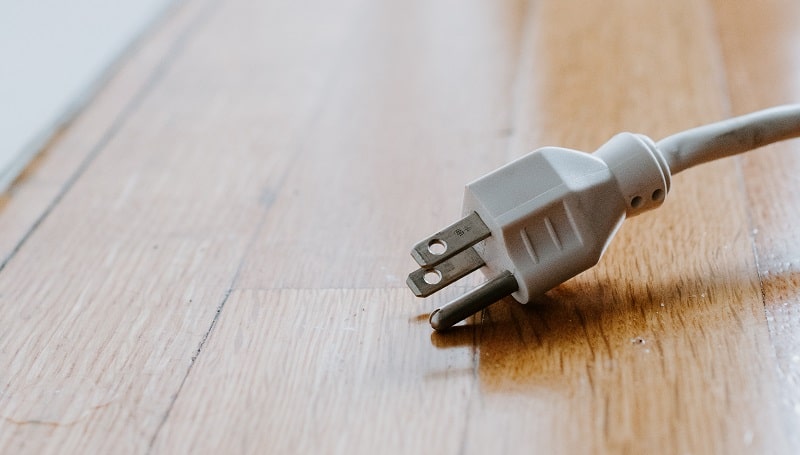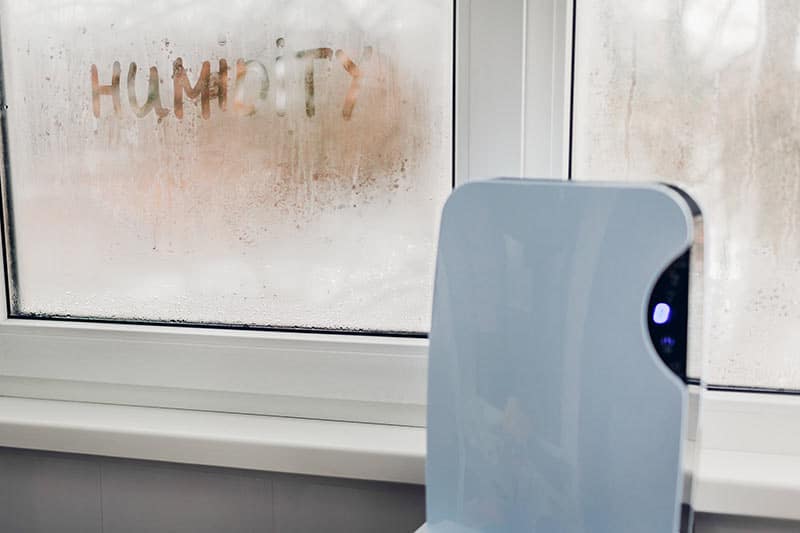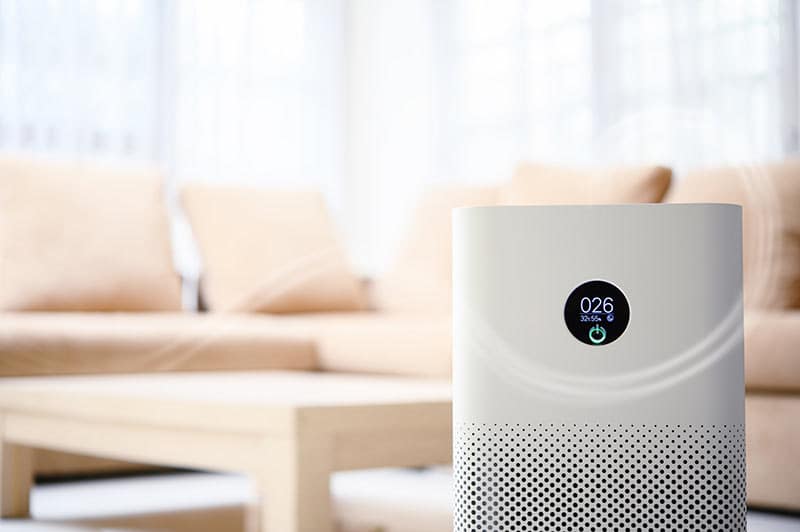Does your dehumidifier seem to be working, but not reducing humidity? The coils inside it might not be doing their job.
Let me paint you a picture.
You get up bright and early to start your day. It’s a rainy morning, so you turn on your dehumidifier, and walk towards the kitchen for a fresh cup of Joe.
You get a couple of things done around the house and walk back into your room, only to realize that the humidity levels are still very high. How is that possible if your appliance has been running since you woke up?
The answer is simple, but you might not like it. Sometimes, your dehumidifier could look fine, and seem to work properly, but be removing moisture inefficiently.
Who would have thought that was even a possibility, huh?
There are several reasons why this could be happening. From faulty coils inside it to a damaged fan motor. You name it, it could be a contributing factor.
Lucky for you, I’ve had this happen to me in the past, so I have a pretty clear idea of what might be wrong.
Below, you will find a list of the most common causes of this occurrence and the simplest steps you can take to address them. I’m confident that, if you stick to them religiously, your dehumidifier will be back to normal in the blink of an eye.
Ready? Let’s get to work!
Fixing a Malfunctioning Dehumidifier
Hey, I get it. You need to get your dehumidifier working normally as soon as possible to prevent any moisture damage to your home. However, no troubleshooting process has ever benefited from doing things rashly or randomly. I need you to be patient and trust me. I promise we will get to the bottom of this.
Here are 6 things that could be compromising your unit’s dehumidification abilities:
- A faulty fan
- A bad coil
- A large room
- Improper room insulation
- Low settings
- A faulty microswitch
#1 A Faulty Fan
The first thing I want us to look at is your fan.
This part is essential to the dehumidification process, as, without it, your appliance is unable to pull in air.
Everything might seem fine with your unit from the outside. Blinking lights and operation noises could trick you into believing that nothing’s wrong. However, even the slightest malfunction in your fan motor, or tiny bends or cracks on your fan blades, could be causing trouble.
If your dehumidifier is working, but not reducing humidity, there is a very good chance that you have to look inside it, and inspect for damage.
Solution: Accessing your appliance’s internal components should not be too difficult. The process will vary from model to model, but the broad strokes should be the same.

Carefully unplug your dehumidifier, and wait a couple of minutes. Remove the frontal plastic panel and the filter, as well as any protective screws behind the part. Once you have done that, you should have clear access to your fan, its motor, and the bearing.
Look closely for any kind of bending or tearing on the blades, and test the motor for continuity with a multimeter (if you have one).
Assuming that you find any kind of malfunction or damage, you will have to replace the affected component. If you’re a visual person like me, there are tons of online videos you can check out, and follow along step by step.
If you want to get any replacement part – or see how much one would cost – click to enter your model number in the search bar below. Our partners at AppliancePartsPros stock almost every part with free guides on how to install them.

#2 A Bad Coil
This can be a little trickier to diagnose than and malfunctioning fan, as your coils are not moving parts.
In case you’re not familiar with what these components do, let me briefly explain. Inside every dehumidifier, there are two coils, one that runs hot, and one that runs cold.
The latter condenses the excessive moisture in the air after it’s pulled in by the fan, while the former warm it up, and releases a drier current back into your room. If either of these coils is damaged or dirty, your appliance could look like it’s working, but not reduce humidity.
Moreover, decreased dehumidification efficiency is not the only problem that stems from neglecting your coils. In fact, other more concerning issues, such as leaking, and overheating, can also originate from this.
It is of the utmost importance that you stop using your machine as soon as you suspect this to be the source of the issue.
Solution: The process of cleaning your coils is very similar to that of accessing your fan. Please follow the steps from the previous point in order to do so.
Once you have comfortable access to your coils, use a clean, damp rag to remove any dirt from them. This should help them work normally again, and restore your unit’s dehumidifying capabilities.
#3 A Large Room

I know you probably won’t like to hear this, but there’s a chance that you will have to get additional dehumidifying solutions for your home.
As you know, every dehumidifier model has a recommended room dimension to guarantee the proper removal of excessive ambient moisture. When, for example, you try to use a model that is not designed for large spaces, to dry a huge living room, you’re bound to encounter a lot of problems.
Now, there’s obviously some wiggle room.
Using an appliance that is designed for smaller rooms, in larger spaces, would reduce humidity less efficiently, but, to some degree, it should work. If you have a moisture meter and notice that the percentage does not decrease at all, the problem lies not with the room size, but with the unit.
Solution: Provided that you notice some degree of humidity reduction, you might want to either get an additional dehumidifier or try those popular absorbent pellets sold at hardware stores.
The pellet solution will be much more budget-friendly, but you’ll have to keep replacing them as they deplete.
You can’t win them all, I guess.
#4 Improper Room Insulation
In theory, your living spaces should already be insulated. However, if your home is very old, the foam in the walls and ceiling might have failed the test of time.
Even the most efficient and modern dehumidifiers in the market cannot counteract the effects of improper insulation. This is especially true if you live in an area with a highly humid climate.
The best way to tell whether you need to replace your insulation foam is by looking out for cold spots, mold, and air drafts in your living spaces. When this problem is not present, the temperature in your room should be evenly distributed.
I know this likely isn’t what you wanted to hear, since insulating your home again can be costly, and time-consuming, but look at the bright side. If this is what’s happening, there’s nothing wrong with your appliance.
Solution: This is a matter of personal preference. If you’re up to the challenge and can spare the time, by all means, go ahead and try to insulate your living spaces yourself.
Otherwise, call a contractor you trust, and do your best to be patient while the job is completed.
#5 Low Settings

I know what you’re thinking, “this is extremely obvious, and would never slip my mind!”. And while normally I’d agree with you, remember that it’s always the most apparently unimportant factor, that we tend to overlook more often.
Before blaming an internal component, or start poking holes in your walls to replace the insulation foam, it might be a good idea to look at your settings.
More often than not, you’ll be using insufficiently high fan speeds relative to your home’s climate. Especially if you like running your appliance in auto mode.
Solution: Provided that you have a moisture meter, feel free to run the following test:
- Measure your room’s humidity percentage with your meter
- Set your dehumidifier to run at the maximum settings
- Let it run for an hour
- Return to the room, and measure the humidity percentage again
If your settings are the problem, the humidity percentage should be lower after running the test.
Bear in mind, though, that running your dehumidifier at the maximum settings at all times, can not only be noisy but also skyrocket your electricity bills. Proceed with caution.
#6 A Faulty Microswitch
Lastly, let’s check your microswitch.
When this component operates normally, it’s able to detect the water levels in your reservoir and prompts the pumps to activate as needed to prevent overfilling. Any malfunction to this part could trick it to believe that the reservoir is full, stopping the dehumidification process.
This technical fault is very tricky as it can be very easily mistaken for malfunctioning pumps or a broken fan motor.
Again, just as it happens with all your other components, it is very important that you stop using your dehumidifier as soon as you suspect this to be the source of the problem.
Solution: Your microswitch is usually located at the side or the back of the reservoir. However, it may vary from model to model.
When you locate the part, carefully detach it from the reservoir and use a multimeter to test it for continuity. Remember that null reading means that the part is dead and needs replacing.
When Should You Call a Pro?
If you’re still under coverage and don’t mind waiting a couple of days or weeks for your manufacturer to send a technician to your home, by all means, go ahead and give them a call.
Unless specified otherwise, they should take care of the repairs for free.
Alternatively, if your warranty has expired, you’ll have to weigh the cost of repairs vs the cost of buying a new model. The replacement parts to fix your dehumidifier are not awfully expensive, but the cost of labor to have them installed and configured can be.
If you want to get any replacement part – or see how much one would cost – click to enter your model number in the search bar below. Our partners at AppliancePartsPros stock almost every part with free guides on how to install them.

Conclusion
A dehumidifier that works, but does not reduce humidity, is like a car that turns on but has no wheels. It looks very nice, but, for all purposes, it’s useless.
Luckily, as I hope you’ve learned in this piece, addressing most of the causes behind this situation is fairly simple, and should not take up a lot of your time.
More often than not, adjusting your settings, and making sure to give your appliance proper maintenance, is all you need to do to keep it working perfectly.
Thank you for reading. If you found this article helpful, why not keep the learning going through our other incredible resources below?







